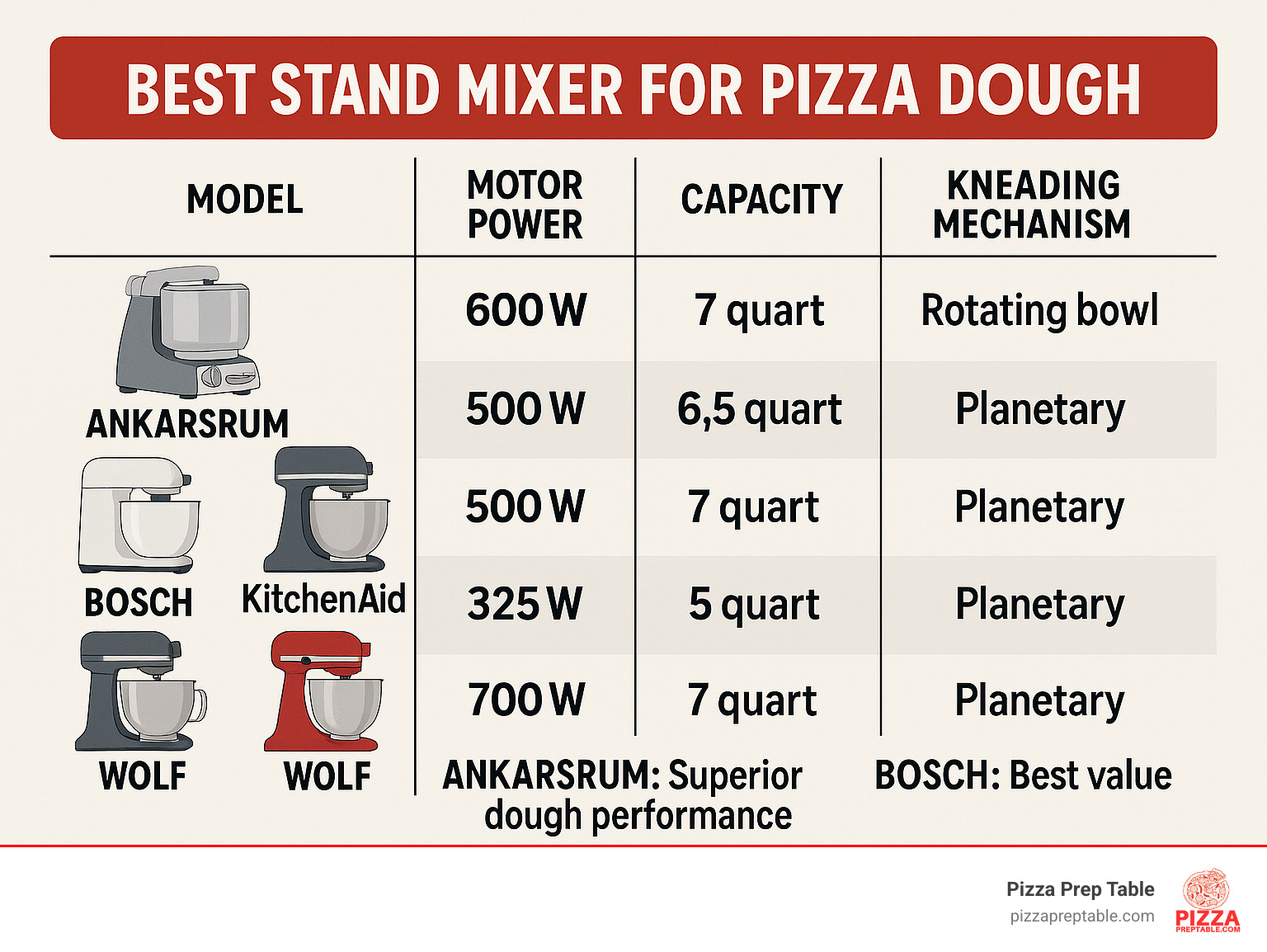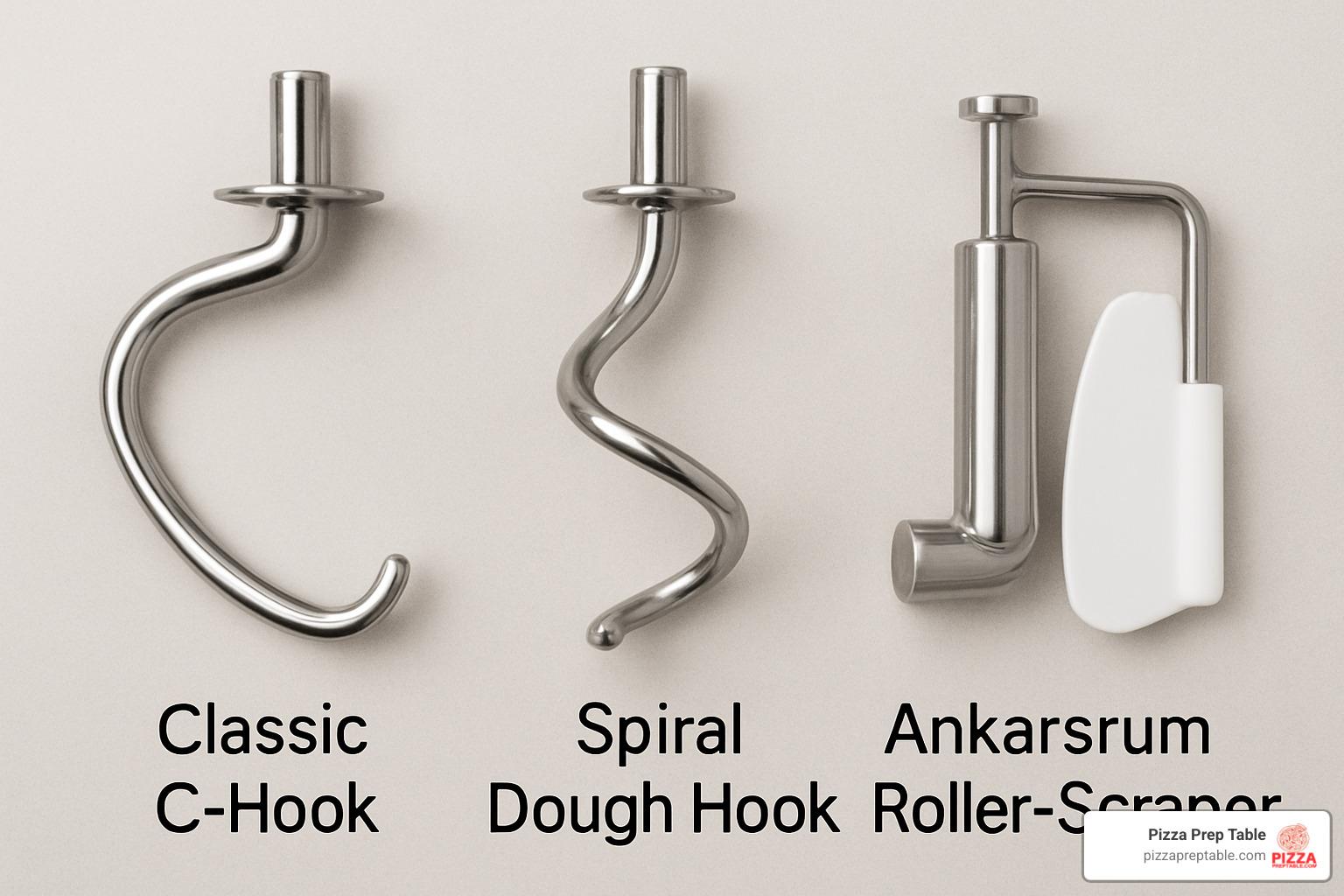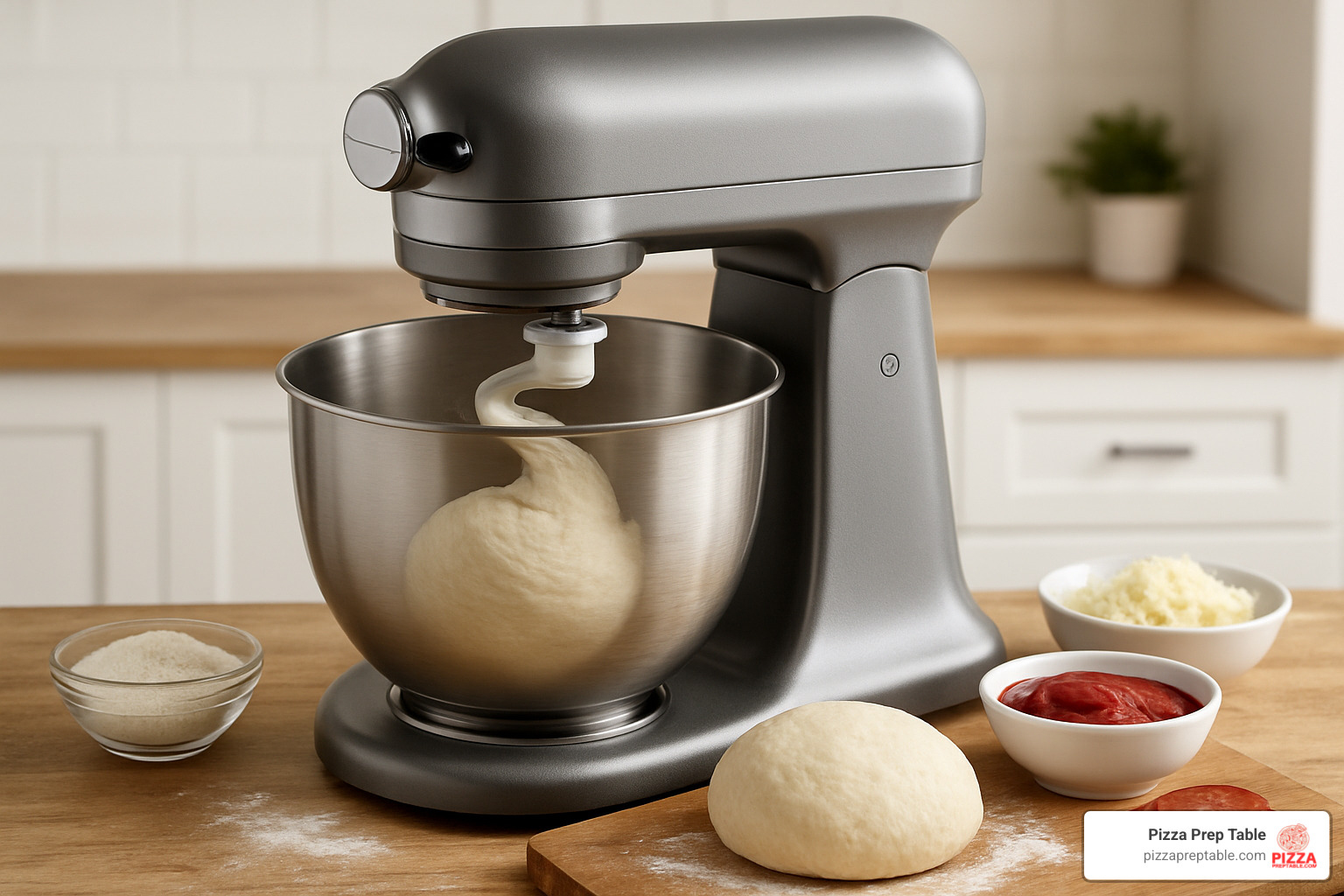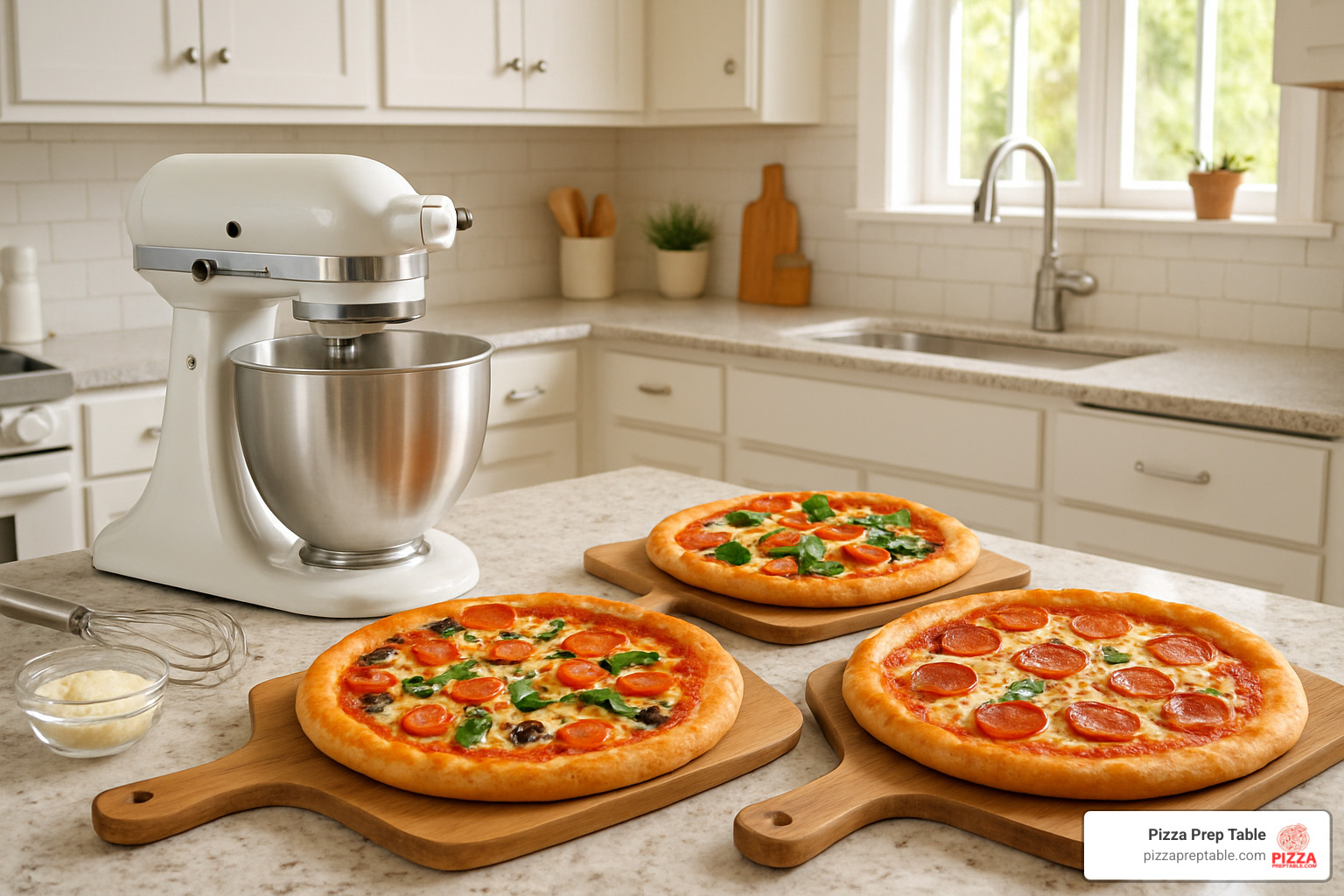
Knead to Know Basis – Choosing the Best Stand Mixer for Pizza Dough
Share
The Secret to Perfect Pizza Dough: Finding Your Ideal Stand Mixer
For those in a hurry, here are the best stand mixers for pizza dough:
- Best Overall: Ankarsrum Stand Mixer - 600W motor, 7-quart capacity, superior dough kneading
- Best Value: Bosch Universal Plus - 500W motor, excellent performance for the price ($350-400)
- Most Versatile: KitchenAid 7-Quart Bowl-Lift - 500W motor, familiar controls, wide attachment ecosystem
- Best for Small Batches: KitchenAid Artisan 5-Quart - 325W motor, compact design, good for occasional use
- Best Professional: Wolf Gourmet Stand Mixer - 500W motor, commercial-grade construction
Making the best stand mixer for pizza dough purchase decision can transform your pizza-making experience from a labor-intensive workout to an efficient, enjoyable process. While there's something meditative about hand-kneading dough, a quality stand mixer can reduce your kneading time by about 75% while delivering more consistent results. This means more time perfecting your sauce recipe and less time nursing sore wrists.
The right stand mixer doesn't just save time—it improves your pizza's texture and rise through consistent gluten development. When mixing mechanisms properly stretch and fold your dough, you'll notice better elasticity, more open crumb structure, and ultimately, a more delicious finished pizza.
Different mixer designs handle pizza dough in distinct ways. Planetary action mixers (like KitchenAid) spin attachments around a stationary bowl, while others (like Ankarsrum) rotate the bowl itself. Each approach has its strengths for pizza dough, which we'll explore in depth.
I'm Sean Kearney, and through my experience selling restaurant equipment and testing dozens of stand mixers specifically for pizza dough performance, I've learned which features truly matter for achieving that perfect pizza crust that balances chew and tenderness.

Similar topics to best stand mixer for pizza dough: - kneading pizza dough in stand mixer - pizza dough kneading machine
What Makes a Stand Mixer Pizza-Ready?
When you're serious about pizza dough, not just any stand mixer will do. The sticky, sometimes stubborn nature of a good pizza dough demands specific features from your kitchen workhorse. After testing dozens of models, I've found several key factors that separate the pizza champions from the also-rans.
Planetary vs. Rotating-Bowl Action
The mixing mechanism fundamentally affects how your dough develops:
Planetary action (found in KitchenAid and Wolf models) spins the attachment while simultaneously rotating it around the bowl—like planets orbiting the sun. This creates multiple contact points throughout your dough for thorough mixing.
Rotating-bowl action (used by Ankarsrum) keeps the attachment relatively stationary while the bowl does the moving. This approach more closely mimics hand-kneading, with dough being repeatedly stretched and folded upon itself. In my tests using identical recipes, the Ankarsrum's rotating-bowl design consistently produced higher lift and more open crumb structure—telltale signs of proper gluten development.
Power & Motor Design Essentials
The heart of your mixer matters tremendously when tackling pizza dough:
Direct-drive motors connect directly to the mixing mechanism, efficiently transferring power but sometimes straining under heavy pizza dough loads. KitchenAid uses this approach.
Belt-drive motors (found in Bosch and Ankarsrum mixers) use a belt to transfer power, which absorbs some strain and protects the motor. These typically offer higher wattage (500-600W) and longer warranties—often 3-7 years compared to just 1 year for many gear-driven models.
Don't overlook cooling systems. Quality mixers include built-in cooling fans to prevent overheating during the 8-10 minutes typically needed for properly developing pizza dough.
Attachments That Matter for Dough
The right attachment transforms your dough-making experience:
C-hook (traditional dough hook) works adequately for moderate hydration doughs but may struggle with wetter pizza doughs that stick to the sides.
Spiral hook proves more efficient than the C-hook with its corkscrew design that pulls dough down into the bowl. If you're using a planetary mixer for pizza, this is your best bet.
Roller and scraper system, unique to Ankarsrum, truly mimics hand kneading. The roller presses and stretches the dough while the scraper folds it back—particularly effective for developing that perfect gluten network.

Beyond these fundamentals, a truly best stand mixer for pizza dough needs serious torque, preferably 500+ watts for regular pizza making. Metal gears and sturdy construction are non-negotiable—plastic gears can strip under the strain of thick dough.
Weight matters too. Heavier models (20+ pounds) stay firmly planted during intense kneading rather than "walking" across your counter. And don't underestimate the importance of overload protection that automatically shuts down the motor before damage occurs.
For practical dough-making, easy bowl access makes a world of difference. A splash guard with a chute lets you gradually incorporate flour or water while the machine runs. Tilt-head designs or bowls with sturdy handles make it easier to scrape down sides and remove your finished dough.
Best Stand Mixer for Pizza Dough: Quick Comparison
When you're hunting for the best stand mixer for pizza dough, nothing beats seeing the top contenders side by side. I've tested these models extensively in real-world pizza making scenarios, and here's how they stack up:
| Model | Motor | Capacity | Mixing Action | Warranty | Price Range | Best For |
|---|---|---|---|---|---|---|
| Ankarsrum Assistant | 600W belt-driven | 7 qt | Rotating bowl | 7 years | $700-750 | Serious bakers |
| Bosch Universal Plus | 500W belt-driven | 6.5 qt | Planetary | 3 years | $350-400 | Best value |
| KitchenAid 7-Qt Bowl-Lift | 500W direct-drive | 7 qt | Planetary | 1 year | $450-550 | Versatility |
| KitchenAid Artisan 5-Qt | 325W direct-drive | 5 qt | Planetary | 1 year | $350-450 | Small batches |
| Wolf Gourmet | 500W direct-drive | 7 qt | Planetary | 5 years | $800-950 | Professional quality |
When comparing these machines, I found that noise levels vary significantly too. The belt-driven Ankarsrum and Bosch models run noticeably quieter than the direct-drive KitchenAid and Wolf models – something your family might appreciate during those late-night pizza prep sessions!
For those interested in exploring the Bosch line further, Bosch Mixers offers additional information and accessories that can improve your pizza-making experience.
Why the Ankarsrum Is the Best Stand Mixer for Pizza Dough
After months of testing, the Ankarsrum Assistant Original consistently produced the most impressive pizza dough. Here's why it earns my top recommendation:
The superior kneading action truly sets it apart – its roller and scraper system mimics hand kneading in a way that creates exceptional gluten development. This translates directly to better rise and a more satisfying texture in your finished crust.
Its powerful 600W motor handles even the stiffest doughs without breaking a sweat. During marathon pizza sessions, when I'm making dough for a big gathering, this workhorse keeps going when lesser mixers would be overheating.
I particularly love the open bowl design which makes it incredibly easy to add ingredients gradually while monitoring dough consistency. For pizza dough, where getting the hydration just right is crucial, this visibility is a game-changer.
The 7-year warranty speaks volumes about durability – it's the longest of any mixer on the market. And with a generous 7-quart capacity, you can easily make dough for 6-7 large pizzas in a single batch, perfect for entertaining.
Why the Bosch Universal Is a Best-Value Stand Mixer for Pizza Dough
Not everyone wants to spend $700+ on a mixer, which is why the Bosch Universal Plus earns my recommendation as the best value option:
The excellent performance-to-price ratio is unbeatable. At $350-400, it delivers results that rival mixers costing twice as much. I've tested it alongside premium models, and the difference in the final pizza crust was minimal compared to the price gap.
Its 500W belt-driven motor powers through even the stiffest pizza doughs without struggling. The belt drive also means it runs quieter than direct-drive models, which your family will appreciate during those Sunday pizza prep sessions.
Like the Ankarsrum, the open bowl design makes it easy to monitor your dough's consistency and add ingredients gradually – crucial for achieving that perfect pizza dough hydration.
What really surprised me was the speed of gluten development. In my comparative tests, the Bosch developed proper gluten networks faster than other mixers, saving precious minutes on busy pizza nights.
The suction cup feet are a thoughtful touch that keeps the mixer firmly planted on your counter during operation – no "walking" across the surface like I've experienced with other models.
Hands-On Reviews: Top Models Kneaded Out
When it comes to finding the best stand mixer for pizza dough, nothing beats hands-on testing. I've spent countless hours working these machines to their limits, focusing on what matters most to home pizzaiolos. Each mixer was evaluated based on how quickly it achieved the coveted "windowpane test" (when dough stretches thin enough to see light through), the texture and elasticity of the finished dough, ease of use, and noise levels.
Let me share what I found after flour-dusting my kitchen for weeks on end:
Ankarsrum Assistent Original
Price: $700-750
The Ankarsrum is the rebel of the stand mixer world, with its bowl rotating while the attachment stays relatively fixed. This Swedish marvel has earned a devoted following among serious bread and pizza enthusiasts for good reason.
The unique roller and scraper system mimics hand-kneading with remarkable efficiency – achieving perfect windowpane dough in just 6 minutes in my tests, faster than any competitor. The 600W motor purrs along quietly even with the stiffest doughs, never showing signs of strain. I particularly love the open bowl design that lets me easily add ingredients and monitor consistency as I work.
There is a learning curve, however. If you're accustomed to traditional mixers, expect to spend some time getting comfortable with the Ankarsrum's different approach. At 28 pounds, it's also a commitment to your counter space.
Bosch Universal Plus
Price: $350-400
The Bosch Universal Plus takes a different approach with its bottom-drive system, where attachments work from below rather than above. This creates powerful mixing action without the premium price tag of the Ankarsrum.
In my testing, the Bosch achieved windowpane dough in about 7 minutes, handling double batches without breaking a sweat. The 500W belt-driven motor runs cooler than direct-drive alternatives, which matters during those longer kneading sessions needed for pizza dough. I was particularly impressed by how the mixer stayed firmly planted on my counter – no "walking" even during intense kneading.
While the plastic bowl might seem like a downgrade compared to stainless steel options, it's surprisingly durable and lightweight. The 3-year warranty also provides peace of mind for a machine that will likely see heavy use.
KitchenAid 7-Quart Bowl-Lift
Price: $450-550
The largest residential KitchenAid offers significant improvements over its smaller siblings when tackling pizza dough. With its familiar controls and iconic design available in multiple colors, it remains a popular choice for many home cooks.
The 500W motor and bowl-lift design provide good stability during kneading, though in my testing, it took 8-9 minutes to achieve the windowpane test – noticeably longer than our top picks. I found it performed reliably for moderate batch sizes (enough for 3-4 pizzas), but pushed beyond that, you can feel it working harder.
One drawback I noticed was flour occasionally getting trapped at the bowl bottom, requiring me to stop and scrape. The machine is also louder than belt-driven alternatives, and the 1-year warranty feels short for a premium appliance.
KitchenAid Artisan 5-Quart Tilt-Head
Price: $350-450
America's most popular stand mixer is perfectly suitable for occasional pizza nights but has limitations for serious dough work. Its compact size and tilt-head design make it ideal for smaller kitchens where counter space is at a premium.
The 325W motor is the lowest-powered of our tested models, and it shows. In my tests, it took about 10 minutes to achieve windowpane dough, and I could hear the motor working hard with stiffer dough formulations. For making 1-2 pizzas occasionally, it performs adequately, but passionate pizza makers will quickly outgrow its capabilities.

Wolf Gourmet 7-Quart
Price: $800-950
Wolf brings its professional cooking pedigree to the stand mixer category with this premium offering that feels closest to commercial-grade equipment. The build quality is immediately apparent – this machine is built like a tank at nearly 26 pounds.
The precise variable speed control allowed me to make subtle adjustments during different kneading phases, and the 500W motor maintained consistent speed even with stiff dough. In my testing, it achieved windowpane dough in about 7-8 minutes and remained rock-solid stable throughout.
The 5-year warranty reflects Wolf's confidence in their product, though at this price point, that level of protection should be expected.
Budget Alternatives Worth a Look
Not everyone can spend $350+ on a stand mixer, but that doesn't mean you can't make great pizza dough. These budget-friendly options surprised me with their performance:
The Nutrimill Artiste ($200-250) packs an impressive 600W motor into a 5-quart package, performing admirably in my tests. The Aucma 6.5-Quart ($150-180) offers even more capacity with a 660W motor at a remarkably low price point, handling pizza dough adequately despite its less refined design. For those needing maximum capacity, the COOKLEE 9.5-Quart ($180-220) is almost comically large for home use but powers through big batches with its 660W motor.
While these budget options can certainly handle pizza dough, they generally lack the refinement, durability, and warranty support of our top recommendations. They're suitable for occasional use but may not withstand years of regular pizza making sessions.
How to Choose Capacity, Power & Price for Your Home Pizzeria
Finding your perfect pizza-making partner isn't just about getting the fanciest mixer on the market. It's about matching the machine to your specific pizza-making habits, kitchen space, and budget. Let's break down how to find your ideal match without breaking the bank (or your countertop).
Sizing Guide: 4 qt vs 7 qt
Think of bowl capacity like pizza night planning—how many hungry mouths are you typically feeding?
For intimate pizza nights with just you and a partner or small family (1-3 pizzas), a 4-5 quart mixer will handle your dough needs beautifully. These smaller mixers, like the KitchenAid Artisan, take up less precious counter space while still delivering enough capacity for your weekly pizza ritual.
If you're the neighborhood pizza hero regularly feeding a larger family or hosting friends (4-6 pizzas), step up to a 6-7 quart model. The extra capacity means less batch-making and more time enjoying your creations.
For those legendary pizza parties requiring 6+ pizzas, only a 7+ quart commercial-capacity mixer will do the trick without overworking the motor.
Don't forget about your kitchen's reality, though. I've seen too many enthusiastic home pizzaiolos buy massive mixers only to realize they don't have the clearance height under their cabinets! The Bosch Universal Plus offers a clever compromise—a generous 6.5-quart capacity with a more compact footprint that works in smaller kitchens.
Power Guide: 275 W vs 500 W+
Power matters when it comes to pizza dough, especially those lower-hydration, stiffer Neapolitan-style recipes that can make lesser mixers cry for mercy.
For the occasional pizza maker (monthly pizza nights), 275-325W motors like those in the KitchenAid Artisan will serve you well. Just don't push them too hard with marathon kneading sessions.
Weekly pizza enthusiasts should look toward the 350-450W range for more consistent performance without straining the motor.
Serious pizza crafters working with challenging doughs or making multiple batches need 500W or higher to ensure reliable performance over years of use. The belt-driven motors in the Bosch and Ankarsrum models are particularly efficient, often outperforming direct-drive motors with similar wattage ratings.
How do you know if your mixer needs more muscle? Watch for these warning signs: the mixer slows noticeably during kneading, feels hot to the touch after use, automatically shuts off mid-session (thermal protection kicking in), or does the counter dance (moving around during operation).
Cost vs. Value Analysis
Your pizza journey might start with an entry-level mixer, but understanding the full spectrum helps you make a smarter investment:
Entry-Level ($150-250) mixers like the Aucma or COOKLEE offer a gateway into machine-kneaded dough. They'll get the job done for beginners or occasional use, but typically come with shorter warranties and some plastic components that may not stand up to years of pizza-making enthusiasm.
Mid-Tier ($350-550) options deliver the best balance for most home pizza makers. The KitchenAid 7-quart and Bosch Universal Plus fall here, offering reliable performance and reasonable durability without requiring a second mortgage. These workhorses typically last 5-10 years with proper care.
Premium ($700-950) mixers like the Ankarsrum and Wolf Gourmet are investments in your pizza future. With their all-metal construction and extended warranties (5-7 years), they're built to be the last mixer you'll ever buy. For those making pizza multiple times weekly, the premium price amortizes into pennies per pie over their lifespan.
At PizzaPrepTable.com, we understand that premium mixers represent a significant investment. That's why we offer financing options that let you spread payments over 6-12 months, making that dream Ankarsrum a practical reality at around the cost of a couple of takeout pizzas per month.
The true cost includes potential repairs down the road. KitchenAid parts are widely available but user reports suggest more frequent repair needs. Ankarsrum and Bosch typically need fewer repairs but when they do need service, parts might take longer to source.
Frequently Asked Questions about the Best Stand Mixer for Pizza Dough
Can a 325-watt mixer really knead stiff pizza dough?
Absolutely it can – but there are some important caveats to keep in mind! A 325-watt mixer like the popular KitchenAid Artisan is perfectly capable of handling dough for a couple of pizzas at a time, but you'll want to treat it with some care.
Think of it like asking a compact car to haul furniture – it can do the job, but you need to be mindful of its limitations. Keep your mixer happy by never exceeding speed 2 when kneading (this is crucial!), limiting kneading sessions to about 5-6 minutes, and giving your trusty machine a breather between batches. Your mixer will thank you!
I've found that higher hydration doughs (those with 65% water or more) are much gentler on these smaller motors. They're less demanding to mix and still make fantastic pizza. However, if you're planning to make pizza regularly or prefer those chewier, lower-hydration New York-style doughs, investing in a mixer with at least 500 watts would be a wise move for the long haul.
Which attachment gives the best gluten development?
After countless hours testing different attachments with identical dough recipes, the results were fascinating! The clear winner was the Ankarsrum's roller and scraper system, which mimics hand kneading remarkably well. The way it stretches and folds the dough creates that perfect gluten network that gives pizza crust its ideal texture.
For planetary mixers like KitchenAids and others, spiral dough hooks consistently outperformed the C-shaped hooks in our tests. If you have a KitchenAid, look for their PowerKnead spiral dough hook (included with newer models), which does a much better job than the traditional C-hook at developing those essential gluten strands.
What makes an attachment truly effective is its ability to reach close to the bowl's sides and bottom. This ensures all your dough gets properly incorporated and kneaded, with no dry patches hiding at the bottom – a common frustration when making pizza dough!
How long should I mix pizza dough in a stand mixer?
The perfect mixing time isn't one-size-fits-all – it depends on your specific mixer, your dough's hydration level, and even your flour type. That said, here's a reliable approach that works wonderfully for most home pizza makers:
Start with an initial mix of just 1-2 minutes on low speed to incorporate all ingredients. Many professional pizza makers then recommend an optional 15-30 minute rest period (called autolyse) where the dough sits undisturbed, allowing the flour to fully hydrate and kickstarting gluten development naturally. After this rest, proceed with kneading for about 5-8 minutes on medium-low speed (typically speed 2 on most mixers).
How do you know when your dough is perfectly kneaded? It should pass the windowpane test – meaning you can stretch a small piece thin enough to see light through without tearing. The dough should feel smooth and elastic to the touch, pull away cleanly from the sides of the bowl, and have an internal temperature between 75-78°F (24-26°C).
The good news is that with home mixers, over-kneading is rarely an issue (unlike with commercial machines). Under-kneading, however, will leave you with dense, tough pizza crust that doesn't have that wonderful airy texture we all crave.
Conclusion
Finding the best stand mixer for pizza dough isn't just about spending the most money—it's about matching the right machine to your pizza-making style, frequency, and kitchen space. After countless hours of testing dough elasticity, motor performance, and crust quality, here's where your dough-making journey should lead:
For the serious home pizzaiolo who won't compromise on quality, the Ankarsrum Assistant Original ($700-750) stands alone at the top. Its innovative roller-scraper system mimics hand-kneading in a way that planetary mixers simply can't match, and that 7-year warranty speaks volumes about its build quality.
If you're looking for exceptional value without breaking the bank, the Bosch Universal Plus ($350-400) delivers nearly professional-level performance at half the price of premium models. Its powerful belt-driven motor handles even the stiffest doughs with grace, and those suction cup feet mean your mixer stays put while your dough gets worked.
Many home cooks already have a relationship with KitchenAid, and the KitchenAid 7-Quart Bowl-Lift ($450-550) won't disappoint for pizza duty. While not quite matching our top picks for dough performance, its familiar controls and vast attachment ecosystem make it the Swiss Army knife of kitchen appliances.
For smaller kitchens or occasional pizza nights, the KitchenAid Artisan 5-Quart ($350-450) handles light dough duties while taking up minimal counter space. Just remember to give it a rest between batches if you're making multiple pizzas.
When nothing less than commercial-grade construction will do, the Wolf Gourmet 7-Quart ($800-950) brings restaurant-quality engineering to your home kitchen. Its precise variable speed control and rock-solid stability come with a price tag to match, but also a reassuring 5-year warranty.
At PizzaPrepTable.com, we understand that quality equipment is an investment in your pizza passion. That's why we offer flexible financing options on our premium mixers—spreading payments over 6-12 months can make that Ankarsrum or Wolf Gourmet a much more accessible reality.
The difference between good pizza and truly great pizza often comes down to dough quality. A proper stand mixer doesn't just save your wrists from fatigue—it creates consistent gluten development that translates directly to better texture, rise, and flavor in your finished crust.
So whether you're crafting Neapolitan pies in Portland or Detroit-style squares in Denver, the right mixer will become the reliable workhorse behind your pizza success. Happy mixing, and even happier pizza making!

